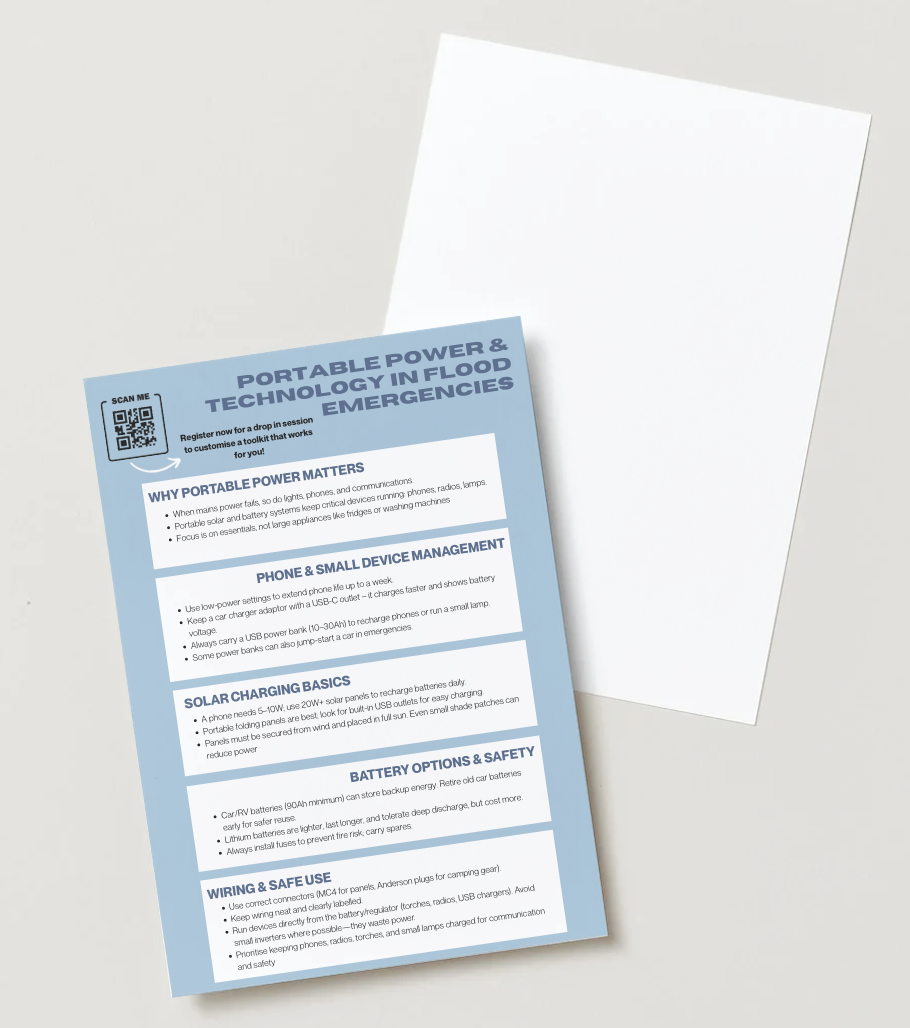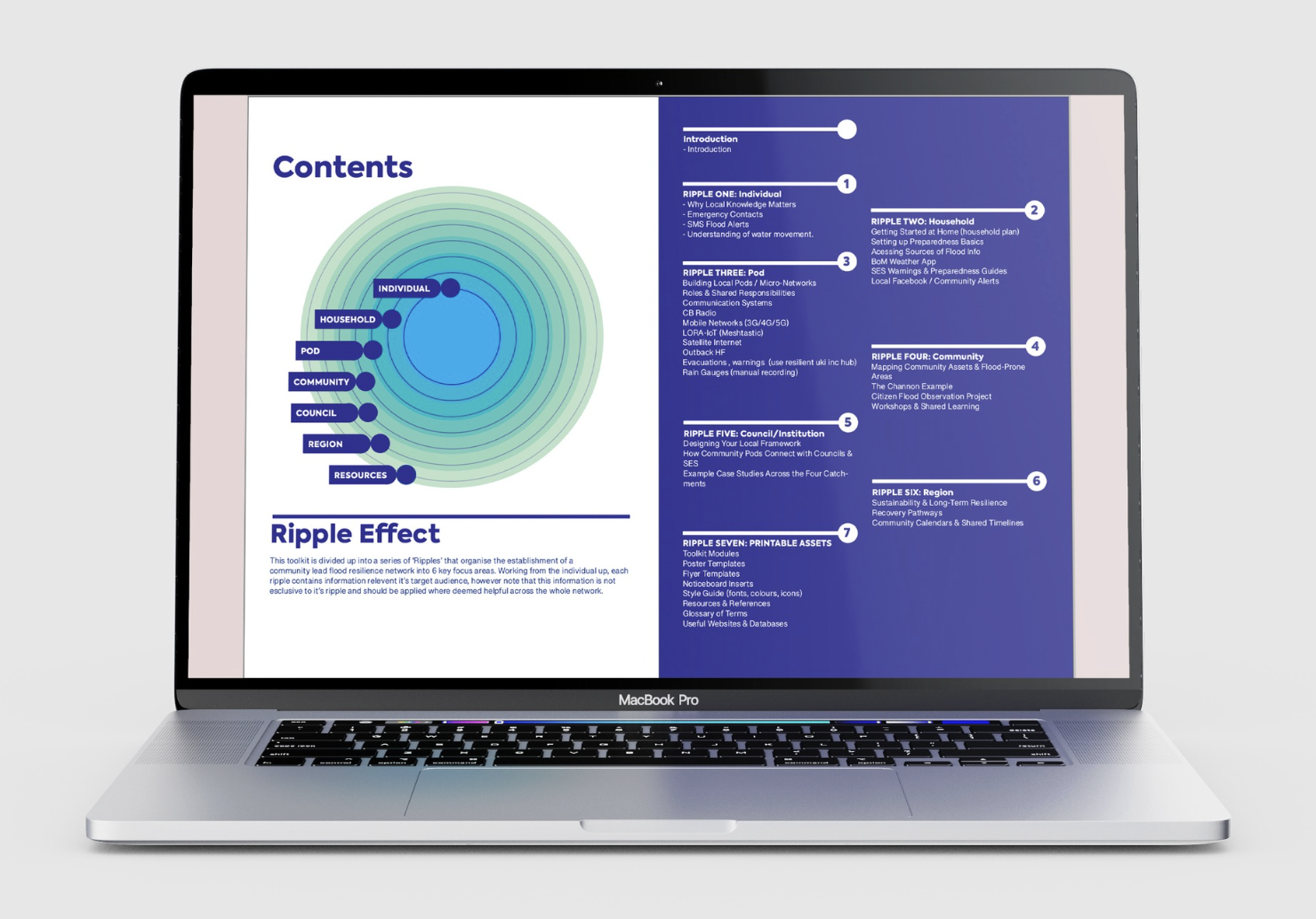Community Led Flood Intelligence.
Project Brief
Project Type: Community Disaster Resilience & Systems Design
Client: Assoc Prof Jeremy Smith, ANU Community Led Flood Intelligence Networks Initiative (Industry Brief)
Duration: University Semester Project 2025
Team: Emma Stannard, Oli Stephens, Sophie Atkins
Role: Information Designer - developed comprehensive flood intelligence framework and community engagement systems
Challenge
Address the critical gap in flood management infrastructure that neglects small communities through faulty alert systems and inadequate emergency communication. Create a scalable framework that empowers rural and remote communities to develop autonomous flood intelligence networks while maintaining consistency for potential nationwide implementation.
Approach
We developed an innovative "Ripple" framework that systematically scales flood preparedness from individual awareness to regional resilience. Through collaborative mapping with Miro, iterative wireframing with Visily, and extensive community consultation, we created a comprehensive seven-stage system that transforms isolated preparedness efforts into interconnected community networks.
Core Design Principles: • Ripple effect methodology scaling from individual to regional implementation • Community-led approach prioritizing local knowledge and autonomy • Systematic information architecture with consistent visual branding • Customizable toolkit design enabling community-specific adaptation • Evidence-based research addressing gaps in existing emergency resources
Solution
Comprehensive Ripple Framework: Seven-stage system progressing from individual preparedness (emergency contacts, flood alerts) through household planning, pod networks, community mapping, institutional integration, regional sustainability, and printable implementation assets.
Customizable Toolkit System: Professional PDF-based resources with accompanying style guide enabling communities to maintain consistent branding while adapting content to local needs and contexts.
Implementation Support: Complete handover documentation for industry partners facilitating seamless transition from academic development to real-world community deployment.
Deliverables
• Complete Community Flood Intelligence Toolkit with seven-stage framework • Comprehensive style guide for community customization and brand consistency
• Professional handover documentation for industry partner implementation • Scalable system architecture supporting nationwide expansion
Outcome
The project successfully created a replicable, systematic approach to community-led flood resilience that bridges grassroots knowledge with professional disaster management frameworks. The Ripple methodology provides communities with clear pathways for building flood intelligence networks while maintaining the flexibility and local ownership essential for sustainable community-led initiatives.
Toolkit
A transferable resource using the "Ripple Effect" framework to guide communities through seven layers of flood resilience. The toolkit is intentionally modular with blank templates and customizable sections that communities fill out based on their specific geography, economics, technical preferences, and social structures. Whether you're in an upper catchment, valley community, coastal area, or mountainous terrain, the framework adapts to your unique context. Drawing on proven examples like The Channon's CB radio network, communities can choose appropriate technologies and insert their own local knowledge, contacts, and evacuation routes while maintaining the community-led approach.
A complete design system ensuring visual consistency while enabling community customisation. The guide specifies typography, colour palette (navy blue, white, lime green), and flexible layout principles including templates for pages, highlight bubbles, tables, and diagrams. Communities maintain professional, recognisable branding while adapting materials to their local context, ensuring cohesive evolution rather than fragmentation across implementations.
Style Guide
Transition materials for continuing the initiative beyond initial development. The handover outlines completed deliverables, Year 2 priorities (community testing, content completion), and Year 3 goals (digital platforms, broader testing). It documents key insights about relationships versus technology and local knowledge importance, while addressing critical questions about digital formats, ownership, and institutional partnerships—providing a roadmap for future development through community co-design.
Project Handover Document
Inital Concepts *
Inital Concepts *
Concept 1 - App Development
We initially conceived an app called 'Local Waters' to address gaps in flood education and communication. The platform would enable collaborative water level monitoring and gauge readings, with users posting real-time updates in a community feed. By selecting their local area, residents would see only relevant information for their catchment. The app would include digital learning modules (replicating the in-person workshops currently held in community halls) and a dedicated section for local updates.
However, feedback revealed that similar digital solutions had been attempted previously without success. More importantly, this approach didn't align with the Flood Intelligence group's vision—while it addressed prevention and education, it failed to foster genuine community connections and didn't adequately support communication during actual flood events when community networks are most critical.
Concept 2 - Physical Community-Based Assets
This concept prioritizes delivering flood information through tangible, accessible formats that reach people regardless of their digital literacy or app usage. We drew inspiration from creative, community-centered approaches like informational beer coasters in rural pubs—spaces where people naturally gather and socialize. By embedding QR codes or quick flood tips on coasters, information reaches audiences in familiar, social settings that encourage organic conversation.
This approach informed our final deliverables: we developed customizable templates and handouts within the toolkit, complete with a cohesive style guide and branding system. We also created promotional coasters specifically designed for pubs and community spaces in rural areas. These coasters serve as conversation starters, fostering the organic discussion essential for successful community engagement and rollout in areas where social gathering places naturally facilitate information sharing and community connection. These templates below were our initial concepts (final concepts match the updated style guide and can be found in the Toolkit).




Concept 3 - Roll Out Framework
A scalable framework designed for adaptation and rollout across NSW and potentially nationwide. The system captures and amplifies the successful knowledge, strategies, and initiatives already implemented by existing communities, transforming local innovations into transferable resources. Community leaders receive information in an accessible, step-by-step format with clear guidance for customizing the framework to address their community's unique geographic, social, and economic context. The framework provides strategic guidance, serves as a centralized information hub, and includes printable community resources.
We ultimately merged the tangible resource concept with the adaptive framework approach, updating our delivery method from a digital app to a comprehensive PDF toolkit. This hybrid solution ensures every community touchpoint is addressed—from individual preparedness through regional coordination—while maintaining the accessibility and customization capabilities that make the framework truly transferable across diverse rural communities.


